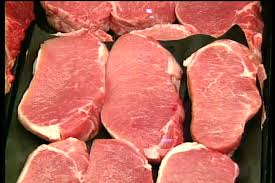Contaminated pork left Andrea Rohachuk curled for hours in agony next to an Emergency Room toilet.
 It sickened more than 100 other Albertans – far more than those made ill by the 2012 XL Foods outbreak. Many of the people affected by last summer’s E.coli outbreak were small children left with failing kidneys.
It sickened more than 100 other Albertans – far more than those made ill by the 2012 XL Foods outbreak. Many of the people affected by last summer’s E.coli outbreak were small children left with failing kidneys.
“It was the worst stomach pain,” Rohachuk recalled in an interview.
“I ended up sleeping on the floor of the bathroom in the hospital. It was so horrible.”
After several hospitalized hours on an IV drip she was sent home, armed with meds that made life bearable in four-hour intervals. In hindsight, she’s just glad her young kids didn’t get sick themselves: They usually share their mom’s meal; it was only by chance Rohachuk relented and let them order fried spring rolls of their own.
“You can imagine how narrowly they missed being brutally sick.”
Almost a year later, nobody knows where the bad meat came from or how to stop a similar E. coli outbreak from sickening as many people again.
“It is not known if pork was contaminated as a result of swine infected at time of slaughter, or, contaminated via other sources after slaughter,” Alberta Health Services spokesperson Shannon Evans wrote in an email.
More than a month after dozens of Albertans came down with gastrointestinal illnesses thanks to foodborne E. coli last summer, Alberta Health Services named Edmonton’s Hiep Thanh and Calgary’s V&T Meat as retailers connected with the outbreak. Hiep Thanh was closed by an Alberta Health Services order on Sept. 3, 2014, and re-opened Sept. 18. V&T Meat was closed Sept. 2, reopened Sept. 8, according to the health agency.
Edmonton’s Vinh Fat Foods and Calgary’s Trimming Fresh Meats and Hiep Hoa Asian also recalled products connected to the outbreak.
But the province’s food-safety inspectors never found the slaughterhouse or processing plant where the tainted meat came from.
The retailers involved are part of “a complex pork supplier matrix,” Health Services’ e-mailed statement reads. Each had more than five suppliers and the province doesn’t know which of these five was responsible for the tainted meat.
Asked if not knowing the source of the contaminated pork is cause for concern, Evans wrote:
“The source of illness was pinpointed: it was contaminated pork products. As AHS, our concern is determining the source of human illness, and that has been determined. There is no ongoing concern for public health, related to this outbreak.”
 Canada is supposed to have health regulations preventing the food you eat from killing or sickening you and ensuring steps are taken to fix things when something goes wrong. Health Minister Rona Ambrose has said Canada has “the safest food system in the world” and accused those raising concerns of fearmongering.
Canada is supposed to have health regulations preventing the food you eat from killing or sickening you and ensuring steps are taken to fix things when something goes wrong. Health Minister Rona Ambrose has said Canada has “the safest food system in the world” and accused those raising concerns of fearmongering.
(Ambrose was unavailable to speak with us for this story. Her office referred us to Canadian Food Inspection Agency President Bruce Archibald, who was not available. We’ve been told a Food Inspection Agency vice-president will be able to speak with us this week. We’ll post that once we have it. )
Seventy-eight per cent of Canadians are concerned about the safety of the food they eat, according to an Ipsos poll of 1,005 Canadians conducted for Global News in late May.
And Global News has found at least two occasions in the past year when authorities were left in the dark as to what foodborne illness was making Canadians sick and how to prevent that contamination from recurring.
Canada pledged to beef up food inspection in the wake of the 2008 Maple Leaf listeria outbreak and the 2012 XL Foods E. coli outbreak. But the regulatory backbone to a food safety act passed in 2012 has yet to be put in place. And even as food supply chains become more complex, the Canadian Food Inspection Agency (CFIA) has fewer resources to police it and less of an emphasis on preventing outbreaks rather than responding to them after the fact.
On April 15, Canada’s Public Health Agency issued a warning regarding “leafy greens” contaminated with E. coli that had made a dozen Canadians sick in Newfoundland and Labrador, Alberta, Ontario and Saskatchewan the month before.
“A specific product has not been identified yet, and the investigation is ongoing,” the release stated, adding that consumers should wash their produce and food-preparation tools well, and keep vegetables away from raw meat in the fridge.
Almost a month later, the number of sickened Canadians was up to 13, 10 of them in Alberta. But the tainted vegetable’s source, or even the type of “leafy green” involved, was never identified.
On May 25, the Public Health Agency of Canada posted a notice online saying it had closed the leafy green investigation two weeks earlier — without ever identifying what “leafy green” made 13 Canadians sick.
It’s a problem when no one knows the source of an outbreak, says food safety expert Doug Powell.
“People talk a lot about [food] traceability. But it’s really not that good,” he said. That’s bad for those seeking to nip an outbreak in the bud and prevent the next one.
“You want to learn: ‘How did that happen? And where are the failures? And what can we learn from this going forward?’
“… That costs money.”
The CFIA vowed to clean up its act after numerous regulatory shortcomings were uncovered in the wake of the Maple Leaf and XL Foods outbreaks. An audit by the U.S. Food Safety Inspection Service, which inspects Canadian plants exporting food to the United States, gave the CFIA the lowest possible passing grade (“Adequate”) and found multiple instances where processing plants weren’t in compliance with safety regulations.
An independent review that found the XL Foods outbreak was “preventable” and due to lax safety inspection recommended the CFIA adopt a stronger “food safety culture;” train its inspectors better; do a better job of enforcing its own rules at the plant level; require better documentation and labelling; and be more transparent about recalls and similar issues.
But the government has yet to enact regulations that would bring its 2012 Safe Food for Canadians Act into force. After consulting with the food industry last summer, the federal government is doing more consultations now, this time with smaller businesses. A spokesperson for Ambrose said there’s no timeline to publish the new regulations but “we’ll take the time to get it right.”
Global News went through a years-long access-to-information process to obtain incident reports on E. coli found in Canadian food plants. When we received printouts and a static PDF of the database containing the reports, much of the information pertaining to safety violations or steps taken to address them was censored, apparently due to privacy concerns of the companies involved.
But when it comes to the safety of your food, Powell argues, corporate privacy shouldn’t be an issue: He argues we need more transparency, not less.
Powell compared it to the pass/fail signs on the windows of restaurants: The more a plant is required to tell the public about its safety record, the more pressure there is to do well.
“What they should do is be very public about their food safety efforts. And actually market food safety,” he said. “If you hold them accountable up front, they’ll do a better job of preventing [product contamination].”
The way things stand now, he argues, grocery shopping “is all faith-based.”
“We know there are certain bad performers. How is a consumer supposed to know who a bad performer is?”
Canadian Meat Council spokesperson Ron Davidson says there’s no need for the public to know every time there’s a pathogen at a processing plant.
“If it’s not going on the market then I’m not sure what benefit you would have to that,” he said.
Ten months after she was sickened by tainted pork whose source we still don’t know, Andrea Rohachuk is much more skeptical of the system supposed to keep her food safe.
The same day Rohachuk ordered that ill-fated bowl of pho, provincial health inspectors were at the Calgary restaurant where she ordered it.
They found dirty cooler doors, dishes, grill and ventilator; poorly stored food; open containers of garbage; and a leaky walk-in cooler repaired with duct tape. They were back two days later, and two days after that. But she heard nothing for ages even after reporting her illness to health authorities.
“I think they did drop the ball. They dropped the ball on the inspections and the rest,” Rohachuk said.
“Why did it take weeks to even track it to that pork? …
“I want to forget about it. [But] I think that something needs to be done.”
 RCMP in Warman, Sask., were allegedly forced to arrest a “stubborn” goat for refusing to leave a Tim Hortons on Sunday morning.
RCMP in Warman, Sask., were allegedly forced to arrest a “stubborn” goat for refusing to leave a Tim Hortons on Sunday morning.










